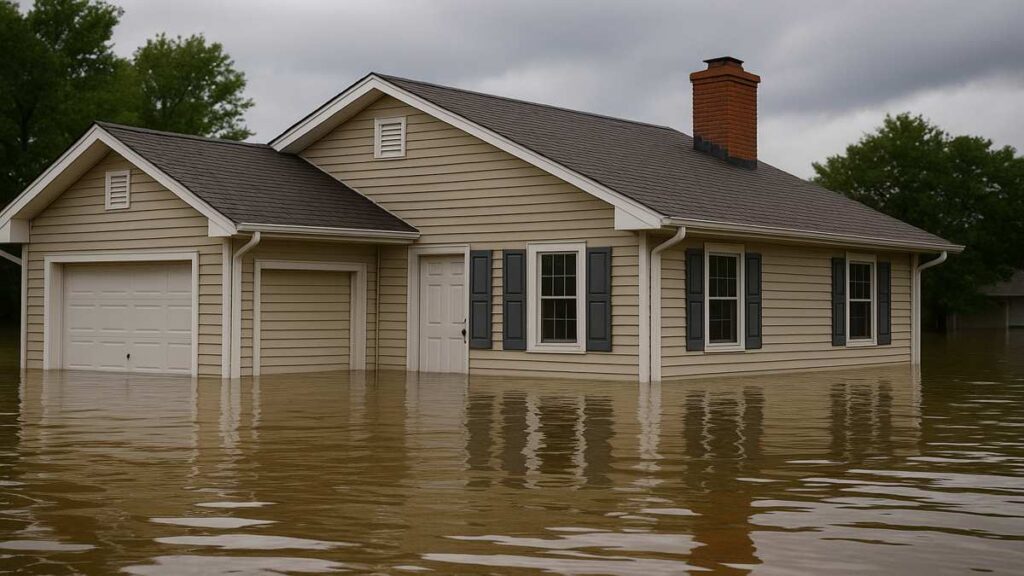
The Hidden Risk: The Flood Insurance Gap
The most common and costly form of natural disaster happening inside the U.S. is the flood, and there are millions of unprotected homeowners. The lack of proper protection exists through so-called flood insurance gap, and this means an overwhelming risk to property owners all over the country.
Why Owners Think They’re Protected
Standard homeowners insurance policies do not include flood damage coverage. Yet, a 2021 national survey showed that nearly 6 in 10 homeowners think they do. This false sense of security fueled by that dangerous misconception persists—until disaster hits.
The National Flood Insurance Program (NFIP) Limitations of FEMA
NFIP is frequently the only choice available to purchase flood insurance, particularly in high-risk locations. However, it comes with several major shortcomings:
- Coverage caps: $250,000 for building, $100,000 for contents
- Excludes other living costs
- Does not include basements, fencing, pools, or landscaping
For homes in coastal cities, suburbs near rivers, or increasingly flood-prone inland areas, these limits may cover just half or less of actual rebuilding costs.
Private Flood Insurance: An Underutilized Solution
Private flood insurance policies can offer:
- Increased coverage limits (up to $1 million+)
- Faster claims processing
- Additional protection (e.g., basement contents, loss of use)
Yet fewer than 5% of U.S. homeowners with flood risk opt for private plans. Why? Lack of awareness, confusing regulations, and premium fears discourage people from exploring their options.
Wildfire Damage Insurance Coverage: What Most Policies Won’t Share With You
The flames are burning longer, traveling longer distances, and affecting areas that previously experienced no fire history. While this new threat exists, wildfire damage protection from within most homeowners’ insurance policies still falls short or does not exist altogether.
How Wildfire Coverage Works
In theory, homeowners insurance does cover wildfire damage. However, insurers are increasingly:
- Rising premiums
- Imposing higher deductibles
- Capping payouts
- Refusing to renew coverage in high-risk areas
If you live near a forest, canyon, or dry brush lot—a suburban one, too—your policy may exclude or include very pricey out-of-pocket costs before any insurance kicks in.
The California Experience: The Cautionary Case
Major insurers such as State Farm and Allstate have suspended new policies in numerous California ZIP codes following consecutive wildfire seasons. Those still covered tend to face:
- Non-renewal notices
- Premium increases of 200% or higher
- Reduced coverage for fire-related damage
Thousands of homeowners have thus been thrown onto state-run insurance pools like the California FAIR Plan. They are not a full coverage plan, just a minimal safety net.
Why This Matters Now More Than Ever
The climate crisis accelerates the ferocity of wildfires and floods. Coupled with outdated risk maps, limited insurance options, and costly construction prices, the ultimate effect is rising numbers of property owners going without insurance or going partially insured.
Here’s how this affects you:
| Risk | Reality Check |
| Flood | 99% of U.S. counties have been impacted since 1999 |
| Wildfire | Over 4.7 million homes are in high-risk zones |
| FEMA Support | Covers very little of rebuilding expenses |
| Insurance Claim Denial | Common by reason of exclusion or lacking documentation |
What Can You Do to Close the Gap?
♦ Reconsider your existing policy every year.
Ensure your dwelling coverage reflects current construction costs.
✅ Ask about wildfire and flood riders.
Such discretionary features might supplement your cover.
✅ Consider private insurance.
Particularly if you reside within a moderate to high-risk location.
✅ Find your risk using FEMA’s Flood Map Service Center:
https://www.fema.gov/
✅ Document your property.
Photograph items, retain receipts, and make an electronic inventory—a necessity for any claim procedure.
FAQs: Flood Insurance Gap & Wildfire Coverage
Does a homeowners policy include flood insurance?
No. You’ll need to buy a separate policy from NFIP or a private insurance provider.
Does standard insurance cover wildfire damage?
Typically yes, although it might be capped or excluded on a high-risk site.
What is the average payout from FEMA after a disaster?
Less than $8,000—far from enough to rebuild.
Are wildfire exclusions legal?
Yes. Insurers can exclude certain risks or cancel policies in fire-prone zones.
Can renters get flood or wildfire insurance?
Yes. Renters can insure their contents through specialized policies.
How often should I check my insurance needs?
At least once yearly—or right after a home renovation, refinance, or disaster.
Conclusion: Take Control Before It’s Too Late
The flood insurance gap and insufficient wildfire damage coverage are two risks most neglected by U.S. homeowners today. Millions are still vulnerable to economic disaster—not because they didn’t want to buy insurance, yet because there’s a misunderstanding about what their policies include.
Don’t wait till too late. Actively take a look at your insurance, estimate your house’s true risk, and take advice from professionals. Nowadays, in this climate-dependent world, being underinsured is virtually just as risky as being uninsured.